Hunter’s Moon follows the Harvest Moon.
When and where to look in 2023: For those of us in the Northern Hemisphere, the bright, round Hunter’s Moon – full moon following the Harvest Moon – rises in the east around sunset on October 28. Be sure to watch on the nights before and after that, too.
Crest of the full moon falls at 20:24 UTC on October 28, 2023. That’s 3:24 p.m. CDT, and more than two hours before moonrise in central North America.
Characteristics of the Hunter’s Moon: The moon is roundest on the day that it’s full. And, on the day of full moon, the moon rises closest to the time of sunset. But the nights before and after full moon will feature a round-looking moon, too. And, like the Harvest Moon, the Hunter’s moon is characterized by a shorter-than-usual time between successive moonrises for several nights in a row, around the night of full moon. So Northern Hemisphere dwellers will see several nights of full-looking moons in twilight skies, ascending in the east as the sun sets in the west, for several nights.
For the Southern Hemisphere, the nights around this full moon feature a longer-than-usual time between successive moonrises. So, for the southern part of the globe, the moon will rise on these nights in a sky that’s already dark.
And there’s an extra attraction on these nights near the 2023 Hunter’s Moon. It’s the biggest planet in our solar system, Jupiter – shining like a floodlight as the brightest “star” in our evening sky – now nearly closest to Earth for this year.
The 2024 lunar calendars are here! Best Christmas gifts in the universe! Check ’em out here.
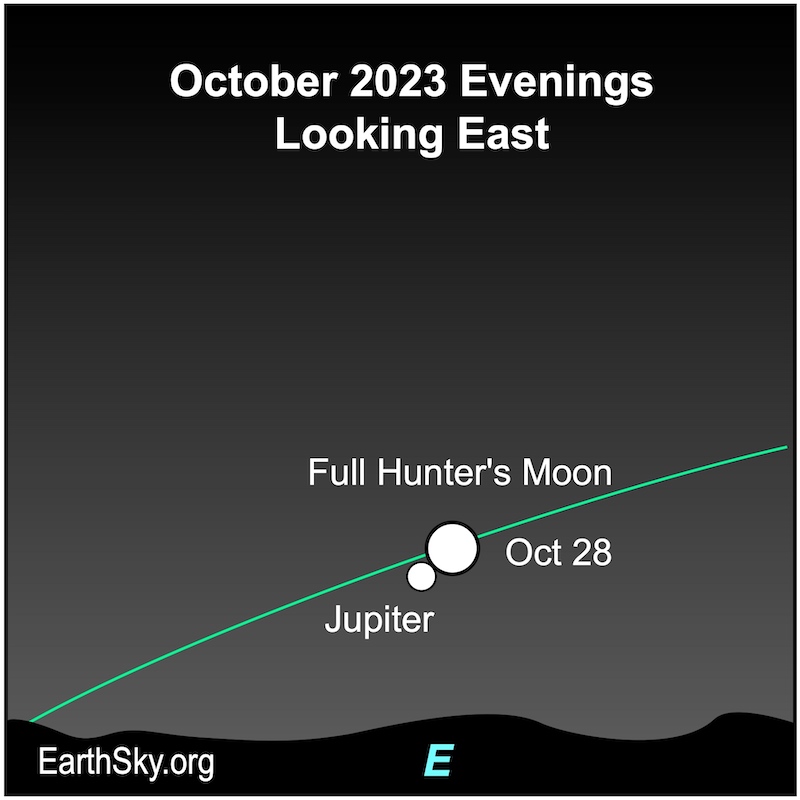
What’s special about a Hunter’s Moon?
A full moon is always opposite the sun in space, and opposite the sun in our sky. So all full moons rise in the east around sunset. And all full moons set in the west around sunrise. But the various full moons have different characteristics.
On average, the moon rises about 50 minutes later each day. But when a full moon happens close to the autumnal equinox – either a Harvest or a Hunter’s Moon – the moon (at mid-temperate latitudes) rises only about 30 to 35 minutes later daily for several days before and after the full moon. The reason is that the ecliptic – or the moon’s orbital path – makes a narrow angle with the evening horizon around the time of the autumnal equinox.
The result is that there’s a shorter-than-usual lag time between successive moonrises around the full Hunter’s Moon.
Early evening moonrises make every Hunter’s Moon special. Every full moon rises around sunset. After the full Hunter’s Moon, you’ll see the moon ascending in the east relatively soon after sunset for a few days in a row at northerly latitudes.
A great source of moonrise times is the Custom Sunrise Sunset Calendar. Once you get to that page, be sure to click the box for “moon phases” and “moonrise and moonset times.”
By the way, since the Harvest Moon is the closest full moon to the equinox, it can come either before or after it. So the Harvest Moon can sometimes fall in October, which it does every three or four years. When the Harvest Moon falls in October, the Hunter’s Moon – the full moon following the Harvest Moon – will fall in early November.
That’ll happen next in 2025.

A word about Jupiter
Jupiter is the biggest planet in our solar system, and the 2nd-brightest “star” (really planet) in our night sky. And late October/ early November is the best time to see Jupiter for all of 2023. The video below has more:
A note to those in the Southern Hemisphere
If you’re in the Southern Hemisphere, your Harvest and Hunter’s Moons center on the March equinox, your autumnal equinox. Much of what we say in his post – the general information about Harvest and Hunter’s Moons – applies to you, too… next March and April.
Right now, your full moon will be doing the opposite of a Hunter’s Moon. That is, for the Southern Hemisphere around the time of the September and October full moons, there’s a longer-than-usual time between moonrises on successive nights.
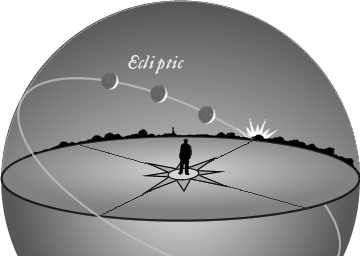
How did the Hunter’s Moon get its name?
There are many stories surrounding the names of the moons, including the Hunter’s Moon. From a practical standpoint, the Harvest Moon and subsequent Hunter’s Moon provided extra light in the evenings for farmers and hunters to finish their tasks.
Every full moon has a slew of nicknames tied to months of the year. But some moon names, such as the Harvest and Hunter’s Moons, are tied to seasons.
In North America, the Harvest Moon was a time when the bright moon meant farmers could stay out later, working in their fields, gathering in the crops before the first freeze. After the harvest, farmers would turn to hunting deer and other animals to bolster their food stores before winter. The bright light of the full moon and almost full moons would let them hunt into the evening hours. So, we call it a Hunter’s Moon.
Who named the Harvest and Hunter’s Moon? Those names probably sprang to the lips of farmers and hunters throughout the Northern Hemisphere, on autumn evenings, at times of the full moon.
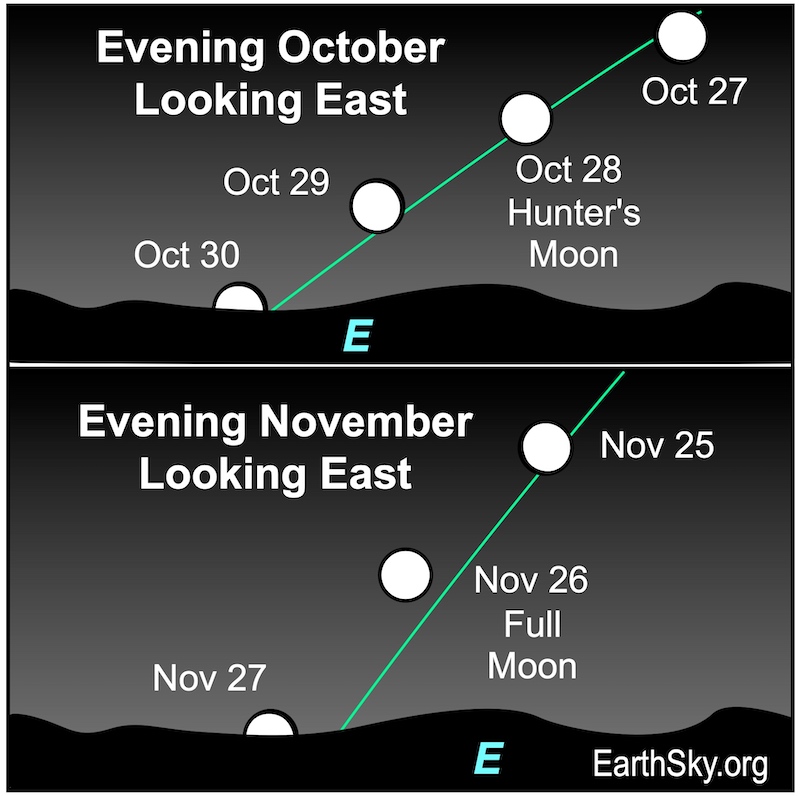
Is a Hunter’s Moon bigger or brighter?
No. The Hunter’s Moon is just an ordinary full moon with a special path across our sky. Still, many of us do think the Hunter’s Moon looks bigger … or brighter … and more orange than usual. Why?
It’s because the Hunter’s Moon has a powerful mystique. Many people look for it shortly after sunset around the time of full moon. After sunset around any full moon, the moon will always be near the horizon … because full moons rise at sunset. It’s the location of the moon near the horizon that causes the Hunter’s Moon – or any full moon – to look big and orange in color.
Orange moon near the horizon. The orange color of a moon near the horizon is a true physical effect. It stems from the fact that, when you look toward the horizon, you’re looking through a greater thickness of Earth’s atmosphere than when you gaze up and overhead. The atmosphere scatters blue light – that’s why the sky looks blue. The greater thickness of atmosphere in the direction of a horizon scatters blue light most effectively, but it lets red light pass through to your eyes. So a full moon near the horizon – any full moon near the horizon – takes on a yellow or orange or reddish hue.
Big moon near the horizon. The bigger-than-usual size of a moon seen near the horizon is something else entirely. It’s a trick that your eyes are playing – an illusion – called the Moon Illusion.
2023 full moon is in Aries
The October full moon typically lies in front of one of three constellations of the zodiac: Pisces the Fishes, Aries the Ram, or Cetus the Whale.
It’s usually in Pisces. That was the case in 2022, and will be the case again in 2024.
But it occasionally lands in Aries, as it does this year.
Infrequently, the October full moon is in the large neighboring constellation to the south, Cetus the Whale.
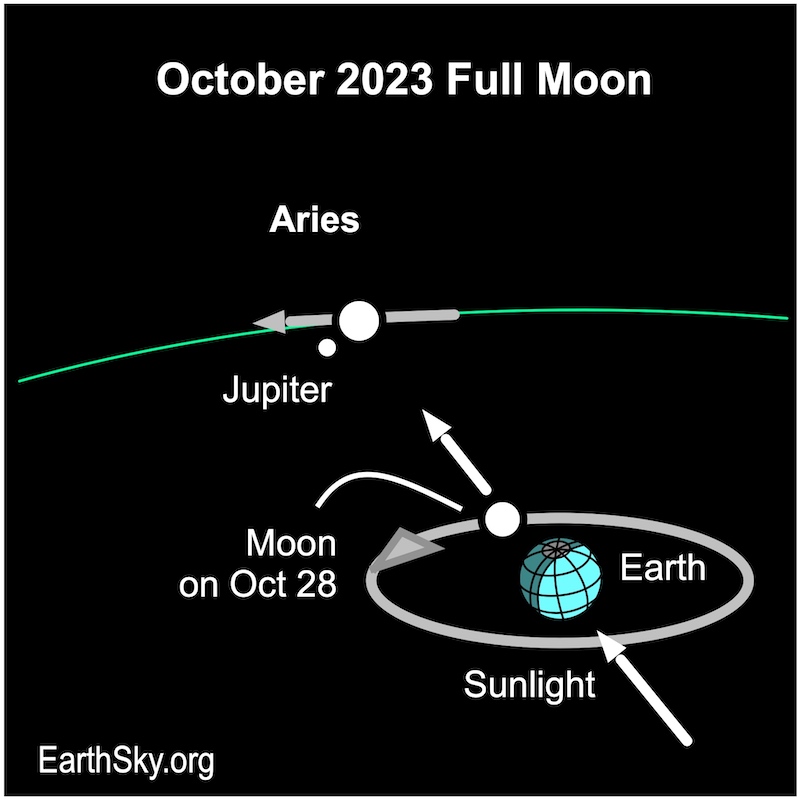
Hunter’s Moon photos from our community
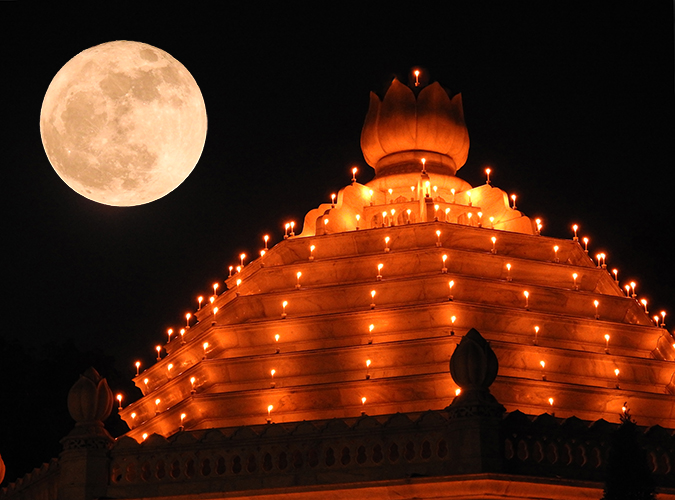
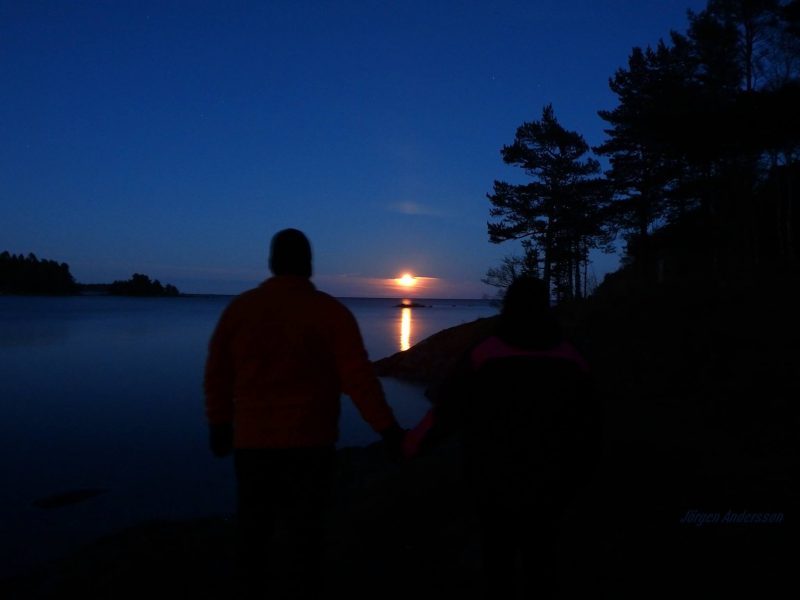
Bottom line: The Hunter’s Moon – this year’s October full moon – is on October 28, 2023. Also, look for bright Jupiter near the full moon. Both are found in front of the constellation Aries.











